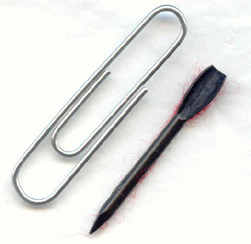Flechettes are very small darts made to fire out of guns. They can be bought somewhat cheaply. They have good accuracy and penetration.

http://www.cheaperthandirt.com/AMM005-57714-1395.html
http://www.auctionarms.com/search/aucti ... =Flechette



These flechettes were never made for accuracy - they're usually loaded into artillery shells for use as area weapons in the manner of a giant shotgun, such as in the M546 105mm round - in fact some would actually be loaded tail first, in order to flip around in flight and spread out more. There are (dubious, but cool) tales of Viet Cong guerillas being found nailed to trees after having been struck by such rounds.but accuracy is what im going for.......... any good ideas for sabots?
hectmarr wrote:You have to make many weapons, because this field is long and short life


I think you mean the rounds developed for the Special Purpose Infantry Weapon programVH_man wrote:i am sure those fletchettes are accurate. i know the US millitary did an in-depth study on fletchette-based weapons, where the weapon fired one fletchette at a time.
from what i remember, the gun itself cost less because it was smoothbore, and the gun had very low recoil.
the problems were that the fletchettes didnt do enough tissue damage and that the fletchette rounds themselves cost aobut twice that of a normal round. besides cost and tissue damage, the fletchette based assualt rifle the US millitary constructed was quite good.......

I can understand your thinking:Others have attempted to achieve the same aim by using flechette technology (in principle, a scaled-down APFSDS tank gun round - APersFSDS?) to achieve an extremely short flight time and flat trajectory resulting from a muzzle velocity of around 1,400 m/s. This gives such weapons an almost ray-gun like performance, with allowances for range, wind-drift and target movement being hardly needed at normal battle ranges. This was first seriously proposed in the American Special Purpose Infantry Weapon (SPIW) project of the late 1960s, in which several manufacturers produced weapons using basically similar ammunition firing 1.8mm diameter darts. Accuracy was not as good as conventional rifles, however, and the cost of the ammunition was very high.
and indeed, they *do* fly as straight as an arrow - but the direction in which they fly is heavily dependent on how effectively the sabot separates without interfering with the flechette, something which even the military found hard to achieve.basically, these fletchettes SHOULD fly straight as an arrow........
hectmarr wrote:You have to make many weapons, because this field is long and short life


hectmarr wrote:You have to make many weapons, because this field is long and short life


but the effect is pretty much the same.A nail or wire with a flattened end is not a true flechette.
That and they either shot out of the sabot while it as still in the barrel, or slowed down in the air because of the sabot's massive drag.I used a paper towel wrapped tightly in electrical tape, so that it formed a solid cylinder. They probably were not flying straight, as I didn't add fins to them.
hectmarr wrote:You have to make many weapons, because this field is long and short life

